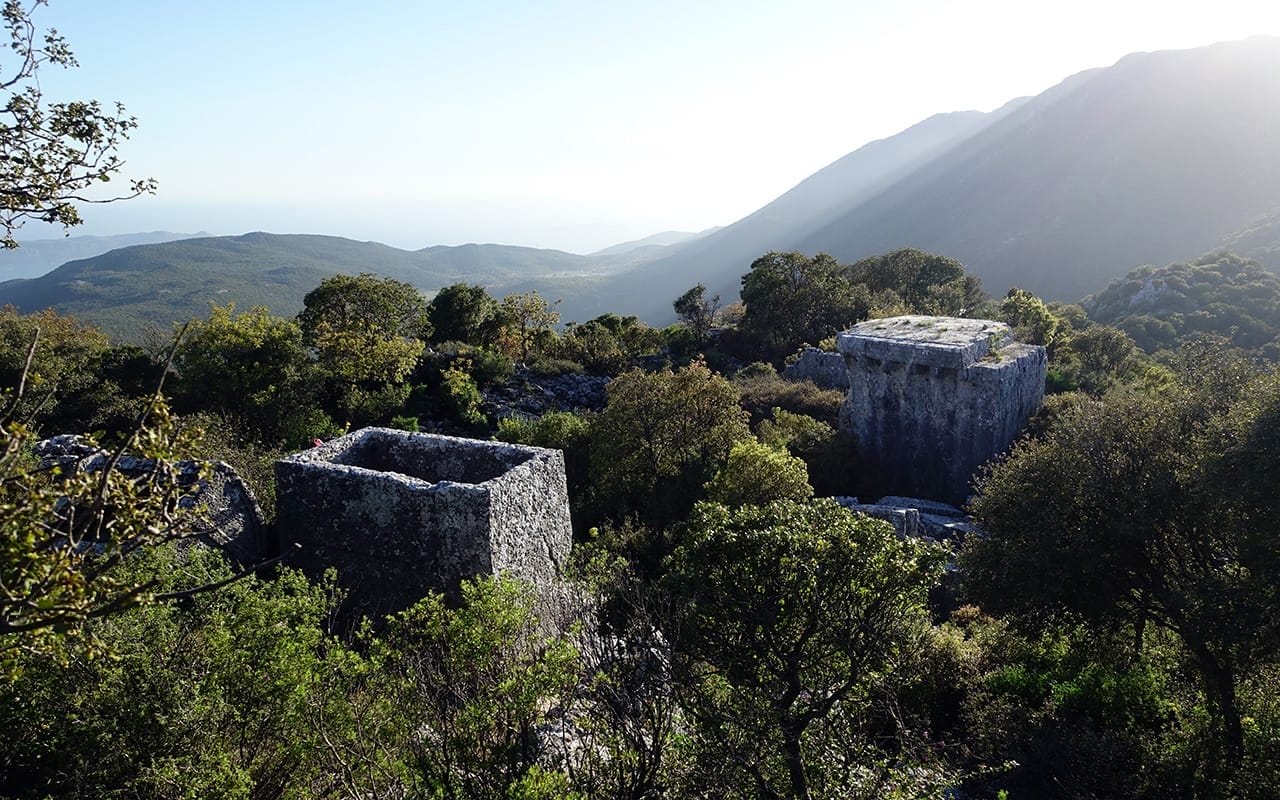If you like visiting historic places, there are many ancient cities you can see in Kas. One of these is the ancient city of Phellos, located to the northeast of Kas at 950 meters above sea level in the Fellen-Yayla area. The archeologic artifacts found at the site and numismatic and epigraphic data show that the history of Phellos dates back to very early periods.
Located 5 km north of Antiphellos, Phellos was inhabited most notably between the 7th and 4th centuries BCE. It was one of Lycia’s four dynastic settlements along with Xanthos, Trysa, and Limyra. Phellos and Antiphellos are some of the few cities in Lycia with Greek names. The name ‘Phellos’, meaning roughly ‘land of rock’ translates to Vehinda (Wehnti) in the Lycian language.

The Ancient City of Phellos
Perched atop a ridge overlooking its mountainous surroundings, Phellos was quite an important city during the 4th century BCE. After its harbor city Antiphellos (Kas) flourished during the Hellenistic Period, Phellos stagnated. When the area now covered by the city of Kas served as a harbor to the ancient city of Phellos became one of the most important points for maritime trade on the Mediterranean.
The information we have on the history of Phellos is limited, but its ruins indicate that it was more a city of defense than of settlement, a fortified area. Looking at the ruins of the ancient city, it’s easy to imagine that it was a city built for defense. The remains of its fortress and its corner watchtowers are evidence of this. In addition, the area on which the fortress was built is easy to defend.
It’s easy to control a large area from the fortress. They built the ancient city of Phellos from a point where it’s easy to see enemies approaching. The city walls surrounding it were also designed for this and to prevent enemies from entering.
Except for the walls surrounding the acropolis of Phellos, the city lacks a lot of other buildings. The ancient city is spread across an area approximately 550 meters long and 200 meters wide. The Phellos acropolis is surrounded completely by walls and made of blocks of the natural limestone found in the region.
The house-type rock tomb found in the western corner of the acropolis is one of the most unique examples of the architecture of Lycian wooden houses reflected in their rock tombs. It’s a family tomb. Walking north from the acropolis, you’ll see many sarcophagi in the valley and on the skirts of the next hill. The one with reliefs is one of the most impressive artifacts in the city.
Address: Phellos Antik Kenti, Cukurbag / Kas / Antalya
Entry Fee: Free
Visitor Hours: No specified visiting hours, always open

The Ancient City of Antiphellos
Antiphellos Theater, Kas
The city of Antiphellos is one of the Lycian Civilization’s most important harbor cities. It was established to serve as the harbor of the ancient city of Phellos, located near Cukurbag Village. Built on top of Kas, the city broke away from Phellos after getting rich from the cedar trade.
Phellos roughly means ‘land of rocks’, while Antiphellos means ‘land without rocks’. It was known as Habesos or Habesa in the Lycian language. Trade enterprises gained importance during the Hellenistic Period and, unlike the declining city of Phellos, Antiphellos grew quickly. Antiphellos obtained one vote in the Lycian League in the 2nd century BCE. This trade city was known for the coins it minted itself and in the name of the league.
The remains of the ancient city are spread throughout Kas. The best preserved of the ruins still standing across the peninsula that spans east to west across the county is the theater of Antiphellos.
The King’s Tomb that you’ll see at the top of Uzuncarsi Street is one of the best-preserved sarcophagi of Antiphellos. It’s not actually known if this tomb belonged to a king or not; it got its name from the lion heads perched on top of it. There are three more sarcophagi in the city center, in the farmer’s market, at the entrance to the harbor, and on the side of the military police (jandarma) building facing the sea.

The Theater of the Ancient City of Antiphellos
The theater of the ancient city of Antiphellos is just a 10 minute walk from the Kas town square. It sits on the southern slope of the acropolis hill and has a wonderful view of the Mediterranean Sea. It has 26 rows of seats.
The seats are split into three sections with four sets of horizontal stairs. You can also see the chamber tomb, which is carved out of the bedrock and features a relief of 24 women, to the north of the theater. Named the Akdam Doric Rock Tomb, it is a slightly conical, square shaped tomb carved out of a stone block measuring a full 4.5 meters by 4.5 meters, not including some of the architectural pieces on top of it.
There is a house with columns and a triangular section on top of columns at the entrance to the tomb. Inside the tomb you’ll see the rows where the dead were placed on all three sides. It was dated to the 4th century BCE by the style of the women and external decorations. Restored in 2008, the theater is one of the best places to watch the sun set in Kas.
Address: Antiphellos Antik Kenti, Kas/Antalya
Entry Fee: Free
Visiting Hours: No specified visiting hours, always open

